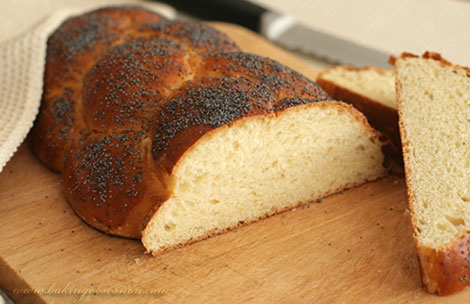
In one of the last issues of “Gourmet” Richard Bertinet shared his recipe and unusual technique of preparing this sweet dough. The dough is sweet but not too sweet which makes it also perfect for savory fillings, not just sweet jams and butter. The whole process is done by hands. And he doesn’t even knead the dough since it’s quite sticky for kneading. He lifts it and slaps it, then stretches and folds it over itself, and does it over and over again, and finally gets a wonderful dough “full of life”. The dough is well know all over France as pain viennois, not so rich alternative to brioche.
You can shape the dough any way you like. I braided it as a 4-strand challah, a really large one. There is enough dough to form two loaves of bread.
Makes two loaves
Ingredients:
- 1 cup plus 2 tbsp whole milk, heated to 115F.
- 1 package (2 ½ tsp) active dry yeast, not a rapid-rise
- 1 lb 2 oz bread flour (about 3 ¾ cups)
- ½ stick (4 tbsp) unsalted butter, softened
- 3 tbsp superfine granulated sugar
- 2 tsp salt
- 2 large eggs
- 1 egg, beaten with a little water, for egg wash
Preparation:
In a large bowl, combine the flour and yeast, then rub in the butter. Stir in the sugar and salt. Fold in the milk and eggs with a flexible plastic bowl scraper, rotating the bowl, until all liquid is absorbed and a wet, sticky dough forms. (The dough will be wetter than most you’ve encountered.) Scrape the dough out onto an unfloured surface. (The dough will be a sticky mess. Don’t be tempted to add more flour. By working the dough through a process of repeatedly stretching and folding it over onto itself, trapping air, the dough will become cohesive and supple.)
Slide your fingers underneath both sides of the dough with your thumbs on top. Lift the dough up (to about chest level) with your thumbs toward you, letting the dough hang slightly. In a continuous motion, swing the dough down, slapping the bottom of the dough onto the surface, then stretch the dough up and back over itself in an arc to trap in air. Repeat the lifting, slapping, and stretching, scraping the surface with the bowl scraper as needed, until the dough is supple, cohesive, and starts to bounce slightly off of the surface without sticking, about 8 minutes.
Transfer the dough to a lightly floured clean surface. Form into a ball by folding each edge, in turn, into the center of the dough and pressing down well with your thumb, rotating the ball as you go. Turn the ball over and transfer into a lightly floured bowl, then cover with a kitchen towel. Let rise in a draft-free place at warm temperature until doubled, about 1 hour.
Form the loaves. Gently release the dough from the bowl with the scraper onto a lightly floured surface (do not punch down) and divide into 2 pieces. Form each piece into a ball. Flatten 1 ball with the heel of your hand into a rectangle (about 8 by 6 inches). Fold in half along the seam, pressing the edges to seal. Put, the seam side down, on a lightly buttered or lined with parchment baking sheet. Repeat with the remaining dough. Let the loaves rise in a warm place until almost doubled, about 1 ½ hours.
Preheat the oven to 425 degrees with the rack in the middle.
Brush the top of the loaves with egg wash. Holding a pair of scissors at 45-degree angle, make snips along the top in a line down the center of each loaf. Transfer to the oven and immediately reduce the temperature to 400 degrees. Bake until the loaves are dark golden brown, 25-30 minutes. Transfer to a rack to cool.
If you decide to form one large loaf instead of two, increase the baking time.

October 28, 2009 at 2:56 am
Mmmm it’s so good with glass of milk and jam. or simply with butter and white coffe